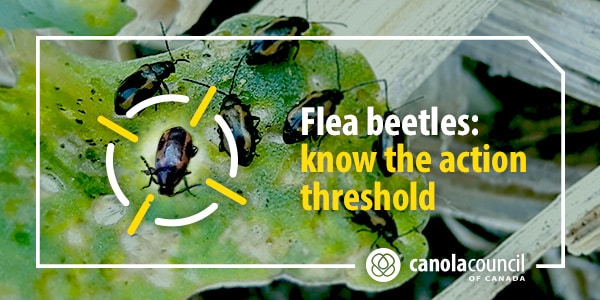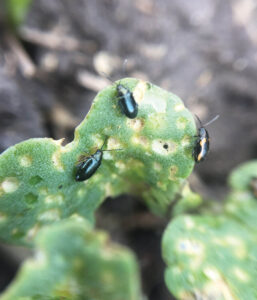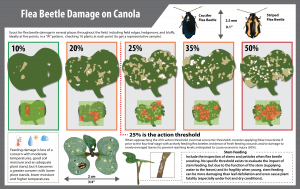The action threshold for flea beetles in canola in Canada is an average leaf area loss of 25 per cent or more. To make that assessment, follow these three steps:
- Figure out how to estimate 25 per cent loss on one plant. Use the graphic below as a guide. This isn’t a perfect science, so do your best. An important note when assessing loss: A plant that has serious (killing) levels of stem feeding can be counted as 100 per cent leaf area loss.
- Estimate the average leaf area loss for 10 plants in the immediate area. Toss your plant counting hoop or anything (like a wrench) to find a random scout spot. Assess 10 plants closest to where it lands, and compute the average leaf area loss per plant. Note that flea beetles will often enter a field from the edges, so edges will give skewed results. Walk toward the middle of the field to find a start point for a first assessment.
- Check a few places throughout the field. The usual scouting technique is to make assessments at five points, in a “W” pattern. Check 10 plants at each point of the “W”. Average the results. Is that average over 25 per cent?
If average loss is over 25 per cent, consider spraying if:

- Flea beetles are still feeding. If it looks like populations are dwindling, an application may not be necessary. If flea beetles are slow and lethargic, it may mean they have ingested seed treatment insecticide and are no longer feeding. If new tissue and young leaves are free of damage, beetles are no longer feeding, and the seed treatments have done their job. See a more detailed description of these steps. Note that time of day and weather can influence flea beetle activity. On rainy days, for example, flea beetles will usually take cover, so rain will slow or even stop feeding for the time being. Rain can also help the crop more quickly recover. Cool and windy weather will drive the flea beetles lower to the ground and may result in stem feeding and/or reduced feeding. Insects are completely temperature driven. Warm weather may speed up beetle feeding more than crop growth increases, so scout more frequently in warm weather.
- Crop is still at high-risk stage. After the four-leaf stage (four true leaves), the threat is likely over because the crop usually has enough plant material to feed flea beetles without compromising growth, and the plants can compensate for feeding better by this stage. If the crop is uneven (some plants are at the four-leaf stage and some are earlier), keep scouting until most of the crop has at least three or four true leaves. Also keep scouting if the crop seems to have stopped advancing due to environmental stress, such as drought. If new material and leaves are emerging with little or no damage, beetle feeding has ended and no foliar application is warranted.
- Plant counts are low. With a thin stand of four or fewer plants per square foot, growers can’t afford to lose any plants. In that situation, they may want to take action quickly as damage approaches 25 per cent leaf area loss.
When to use a lower threshold
Insect management thresholds are not rules posted on product labels. They are guidelines to help farmers make input decisions that provide a return on investment. The action threshold of 25 per cent leaf area loss applies to “normal” crop growth situations. In situations with slow-growing stressed crop, healthy flea beetle populations, and warm, dry weather conducive to feeding, spraying before crop reaches the 25 per cent threshold may be advised. Canola Digest article with more on this.

More…
- Tips to improve foliar spray results
- PODCAST: Flea beetle behaviours
- PODCAST: Flea beetle management webinar
- Canola Encyclopedia chapter on flea beetles
- Late-season flea beetles
- The Agronomists, Ep 100: Drs John Gavloski and Boyd Mori on fighting flea beetles
- Research on flea beetles (on the Canola Research Hub)

